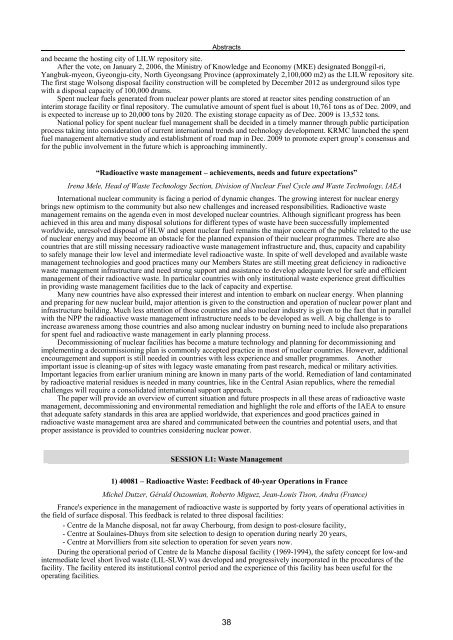The 13th International Conference on Environmental ... - Events
The 13th International Conference on Environmental ... - Events
The 13th International Conference on Environmental ... - Events
Create successful ePaper yourself
Turn your PDF publications into a flip-book with our unique Google optimized e-Paper software.
Abstracts<br />
and became the hosting city of LILW repository site.<br />
After the vote, <strong>on</strong> January 2, 2006, the Ministry of Knowledge and Ec<strong>on</strong>omy (MKE) designated B<strong>on</strong>ggil-ri,<br />
Yangbuk-mye<strong>on</strong>, Gye<strong>on</strong>gju-city, North Gye<strong>on</strong>gsang Province (approximately 2,100,000 m2) as the LILW repository site.<br />
<str<strong>on</strong>g>The</str<strong>on</strong>g> first stage Wols<strong>on</strong>g disposal facility c<strong>on</strong>structi<strong>on</strong> will be completed by December 2012 as underground silos type<br />
with a disposal capacity of 100,000 drums.<br />
Spent nuclear fuels generated from nuclear power plants are stored at reactor sites pending c<strong>on</strong>structi<strong>on</strong> of an<br />
interim storage facility or final repository. <str<strong>on</strong>g>The</str<strong>on</strong>g> cumulative amount of spent fuel is about 10,761 t<strong>on</strong>s as of Dec. 2009, and<br />
is expected to increase up to 20,000 t<strong>on</strong>s by 2020. <str<strong>on</strong>g>The</str<strong>on</strong>g> existing storage capacity as of Dec. 2009 is 13,532 t<strong>on</strong>s.<br />
Nati<strong>on</strong>al policy for spent nuclear fuel management shall be decided in a timely manner through public participati<strong>on</strong><br />
process taking into c<strong>on</strong>siderati<strong>on</strong> of current internati<strong>on</strong>al trends and technology development. KRMC launched the spent<br />
fuel management alternative study and establishment of road map in Dec. 2009 to promote expert group’s c<strong>on</strong>sensus and<br />
for the public involvement in the future which is approaching imminently.<br />
“Radioactive waste management – achievements, needs and future expectati<strong>on</strong>s”<br />
Irena Mele, Head of Waste Technology Secti<strong>on</strong>, Divisi<strong>on</strong> of Nuclear Fuel Cycle and Waste Technology, IAEA<br />
<str<strong>on</strong>g>Internati<strong>on</strong>al</str<strong>on</strong>g> nuclear community is facing a period of dynamic changes. <str<strong>on</strong>g>The</str<strong>on</strong>g> growing interest for nuclear energy<br />
brings new optimism to the community but also new challenges and increased resp<strong>on</strong>sibilities. Radioactive waste<br />
management remains <strong>on</strong> the agenda even in most developed nuclear countries. Although significant progress has been<br />
achieved in this area and many disposal soluti<strong>on</strong>s for different types of waste have been successfully implemented<br />
worldwide, unresolved disposal of HLW and spent nuclear fuel remains the major c<strong>on</strong>cern of the public related to the use<br />
of nuclear energy and may become an obstacle for the planned expansi<strong>on</strong> of their nuclear programmes. <str<strong>on</strong>g>The</str<strong>on</strong>g>re are also<br />
countries that are still missing necessary radioactive waste management infrastructure and, thus, capacity and capability<br />
to safely manage their low level and intermediate level radioactive waste. In spite of well developed and available waste<br />
management technologies and good practices many our Members States are still meeting great deficiency in radioactive<br />
waste management infrastructure and need str<strong>on</strong>g support and assistance to develop adequate level for safe and efficient<br />
management of their radioactive waste. In particular countries with <strong>on</strong>ly instituti<strong>on</strong>al waste experience great difficulties<br />
in providing waste management facilities due to the lack of capacity and expertise.<br />
Many new countries have also expressed their interest and intenti<strong>on</strong> to embark <strong>on</strong> nuclear energy. When planning<br />
and preparing for new nuclear build, major attenti<strong>on</strong> is given to the c<strong>on</strong>structi<strong>on</strong> and operati<strong>on</strong> of nuclear power plant and<br />
infrastructure building. Much less attenti<strong>on</strong> of those countries and also nuclear industry is given to the fact that in parallel<br />
with the NPP the radioactive waste management infrastructure needs to be developed as well. A big challenge is to<br />
increase awareness am<strong>on</strong>g those countries and also am<strong>on</strong>g nuclear industry <strong>on</strong> burning need to include also preparati<strong>on</strong>s<br />
for spent fuel and radioactive waste management in early planning process.<br />
Decommissi<strong>on</strong>ing of nuclear facilities has become a mature technology and planning for decommissi<strong>on</strong>ing and<br />
implementing a decommissi<strong>on</strong>ing plan is comm<strong>on</strong>ly accepted practice in most of nuclear countries. However, additi<strong>on</strong>al<br />
encouragement and support is still needed in countries with less experience and smaller programmes. Another<br />
important issue is cleaning-up of sites with legacy waste emanating from past research, medical or military activities.<br />
Important legacies from earlier uranium mining are known in many parts of the world. Remediati<strong>on</strong> of land c<strong>on</strong>taminated<br />
by radioactive material residues is needed in many countries, like in the Central Asian republics, where the remedial<br />
challenges will require a c<strong>on</strong>solidated internati<strong>on</strong>al support approach.<br />
<str<strong>on</strong>g>The</str<strong>on</strong>g> paper will provide an overview of current situati<strong>on</strong> and future prospects in all these areas of radioactive waste<br />
management, decommissi<strong>on</strong>ing and envir<strong>on</strong>mental remediati<strong>on</strong> and highlight the role and efforts of the IAEA to ensure<br />
that adequate safety standards in this area are applied worldwide, that experiences and good practices gained in<br />
radioactive waste management area are shared and communicated between the countries and potential users, and that<br />
proper assistance is provided to countries c<strong>on</strong>sidering nuclear power.<br />
SESSION L1: Waste Management<br />
1) 40081 – Radioactive Waste: Feedback of 40-year Operati<strong>on</strong>s in France<br />
Michel Dutzer, Gérald Ouzounian, Roberto Miguez, Jean-Louis Tis<strong>on</strong>, Andra (France)<br />
France's experience in the management of radioactive waste is supported by forty years of operati<strong>on</strong>al activities in<br />
the field of surface disposal. This feedback is related to three disposal facilities:<br />
- Centre de la Manche disposal, not far away Cherbourg, from design to post-closure facility,<br />
- Centre at Soulaines-Dhuys from site selecti<strong>on</strong> to design to operati<strong>on</strong> during nearly 20 years,<br />
- Centre at Morvilliers from site selecti<strong>on</strong> to operati<strong>on</strong> for seven years now.<br />
During the operati<strong>on</strong>al period of Centre de la Manche disposal facility (1969-1994), the safety c<strong>on</strong>cept for low-and<br />
intermediate level short lived waste (LIL-SLW) was developed and progressively incorporated in the procedures of the<br />
facility. <str<strong>on</strong>g>The</str<strong>on</strong>g> facility entered its instituti<strong>on</strong>al c<strong>on</strong>trol period and the experience of this facility has been useful for the<br />
operating facilities.<br />
38
















